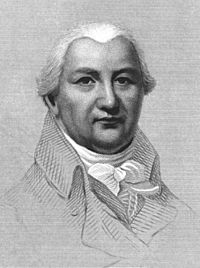Charles Hutton facts for kids
Quick facts for kids
Charles Hutton
|
|
|---|---|
 |
|
| Born | 14 August 1737 Newcastle upon Tyne, England
|
| Died | 27 January 1823 (aged 85) London, England, UK
|
| Nationality | British |
| Awards | Copley Medal 1778 |
| Scientific career | |
| Fields | mathematics |
| Institutions | Royal Military Academy |
| Influenced | John Scott |
Charles Hutton was an important British mathematician and surveyor. He lived from 1737 to 1823. He taught mathematics at the Royal Military Academy from 1773 to 1807. Hutton is famous for calculating how dense the Earth is. He used special measurements taken during the Schiehallion experiment.
Contents
Life of Charles Hutton
Charles Hutton was born in Newcastle upon Tyne, England. His father managed mines but passed away when Charles was very young. Charles went to school in Jesmond. He later took over teaching at that school. Because he had more and more students, he moved the school to a bigger place.
While teaching during the day, he studied mathematics at night. In 1760, he got married. He then started teaching many more students in Newcastle. One of his students, John Scott, later became a very important judge.
Early Works and Surveys
In 1764, Hutton published his first book. It was called The Schoolmasters Guide. This book helped teachers with practical arithmetic. In 1770, he published another book. It was about how to measure things.
Around this time, the city of Newcastle hired him. They wanted him to map the town and its surrounding areas. He created a large map for the city. A smaller map of just the town was also printed. In 1772, he wrote about how to build bridges. This topic came up after a big flood in 1771 destroyed the only bridge in Newcastle.
Professor and Earth's Density
Hutton left Newcastle in 1773. He became a professor of mathematics at the Royal Military Academy, Woolwich. In 1774, he was chosen to be a member of the Royal Society. This is a famous group for scientists.
The Royal Society asked him to do a big calculation. They wanted him to figure out the Earth's mass and density. These numbers came from the Schiehallion experiment. This experiment measured the pull of gravity from a mountain in Scotland. Nevil Maskelyne, a famous astronomer, made these measurements.
Hutton's results were published in 1778. His work on this problem earned him a special degree. It was a Doctor of Laws degree from the University of Edinburgh. He also became a foreign secretary for the Royal Society in 1779.
Later Career and Retirement
Hutton published many more important works. These included Tables of the Products and Powers of Numbers in 1781. He also released his Mathematical Tables in 1785. For the Royal Military Academy, he wrote Elements of Conic Sections in 1787. His Course of Mathematics came out in 1798.
In 1795, he published his Mathematical and Philosophical Dictionary. This book was a valuable collection of information about scientists. He also helped to shorten the Royal Society's Philosophical Transactions. This huge project resulted in 18 large books.
Hutton also wrote for The Ladies' Diary. This was a popular magazine with poems and math problems. He became its editor in 1773 and stayed in that role until 1817.
Because of poor health, Hutton stopped being a professor in 1807. However, he continued to work as a main examiner. He examined students at the Royal Military Academy for several more years. He received a good pension of £500 a year. In his final years, he worked on new versions of his old books.
Charles Hutton passed away on January 27, 1823. He was buried in Charlton, Kent.
Honoring Charles Hutton
Near the end of his life, his friends raised money. They wanted to have a marble statue made of him. A sculptor named Sebastian Gahagan created it. There was extra money, so they also made a special medal. This medal showed Hutton's head on one side. The other side had symbols representing his discoveries. These included his work on gunpowder and the Earth's density.
Works
Here are some of the important books and writings by Charles Hutton:
- A mathematical and philosophical dictionary Vol. I (1795)
- A mathematical and philosophical dictionary Vol. II (1795)
- A mathematical and philosophical dictionary Vol. I (1815)
- A mathematical and philosophical dictionary Vol. II (1815)
- Charles Hutton Tracts on Mathematical and Philosophical Subjects (1812)
- Charles Hutton A Course of Mathematics For the Use of Academies... (volume 1) (1825)
- Charles Hutton A Course of Mathematics For the Use of Academies... (volume 2) (1831)
- Charles Hutton A Treatise on Mensuration both in Theory and in practice (1770)
- Charles Hutton Mathematical tables (1811)

